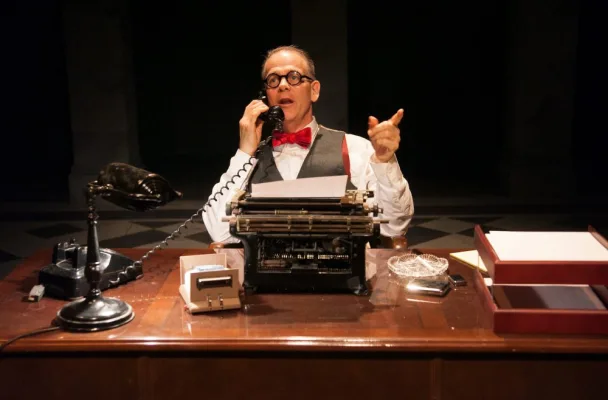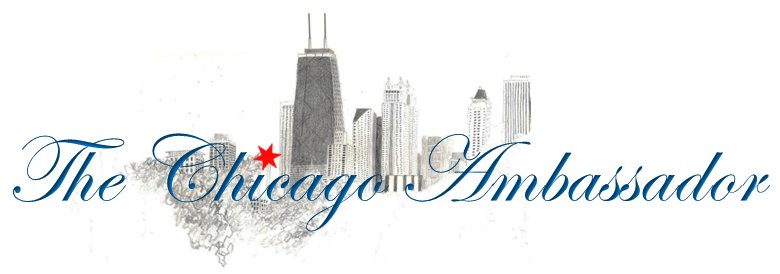Two new Chicago plays tap into the high drama of the newspaper world

Philip Earl Johnson as Joseph Alsop in The Columnist. Photo by Johnny Knight.
A REVIEW BY BOB CHIARITO
Journalism is often a great source of intrigue and two new plays making their world premieres in Chicago use it well for high drama.
The Columnist, American Blues Theater’s production of The Columnist, currently playing at Stage 773, bills itself as being “a drama about power, the press, sex and betrayal,” and while encompasses all that, at its core it’s really about generational differences.
Writer David Auburn won the 2001 Pulitzer for Drama and the 2001Tony Award for best play for his play Proof, and the writing of The Columnist is on the same level.
The story is about real-life reporter Joseph Alsop, (wonderfully played by Philip Earl Johnson) his vulnerabilities , his relationship with his wife (Kymberly Mellen), step-daughter (Tyler Meredith), and brother Stewart (Coburn Goss), who he teamed with to produce a syndicated column from the mid 1940s to the 1950s. The play, directed by Chicago native Keira Fromm, focuses mostly on Joseph’s writing career after his partnership with his brother, with the play’s focus on the years 1960 (when his friend John Kennedy was elected) until 1968. The play ends in shortly after Joseph’s brother Stewart’s death in 1968 (In real life, Stewart Alsop died in 1974, one of the liberties Auburn took).
Joseph Alsop was a man with a big vulnerability — potentially being setup by the KGB to expose his closeted homosexuality — something that lingers through most of the play. But beyond that, and beyond the backdrop of journalism, the play is about the differences in Alsop’s generation and the generation of younger reporters like David Halberstam (Ian Paul Custer) and the even generation of his step-daughter’s generation.
Alsop was of an older, more conservative generation despite his closeted homosexuality, considered taboo and potentially career-ending back then. Some of his being behind the times is exemplified by the way he still used a manual typewriter and wore three-pieces suits into the late 1960s. Beyond that, his dislike of the younger reporter Halberstam and “Sheehan”, (a reference to reporter Neil Sheehan, who does not appear in the play) was another, more obvious example.
Alsop represented the old guard of American journalism much like the older, more conservative generation than the one that came 20 years later and hit adulthood at the height of the war in Vietnam. He grew up attending a private boarding school and then Harvard and was related to Presidents Theodore Roosevelt and James Monroe. His parents were staunch Republicans — his father unsuccessfully sought the governorship of Connecticut several times and both his parents served in the Connecticut General Assembly. While those facts are not mentioned in the play, it is obvious that Alsop came from a more “elite” background — his friendship with John Kennedy being one example — than the lower class, younger generation of reporters exemplified by Halberstam in the play.
In the play, Joseph Alsop rails against the younger reporters, calling them “boys” and there is a great scene of him arguing with his brother over their credibility. In the scene, Stewart stands up to his brother Joseph, who put him down multiple times in the play, telling him that Halberstam and Sheehan actually were in bush with the grunts while Joseph was getting his information at cocktail parties from Secretary of State Robert McNamara and General and General William Westmoreland — a fact that the out-of-touch Joseph is proud of. Of course, McNamara and Westmoreland were two of the biggest villains in the eyes of the the younger, “hippie” generation — one in which his step-daughter somewhat predictably ends up joining.
But unlike Peter Boyle’s character “Joe” in the 1970 film of the same name which featured an older, conservative man out of touch and at odds with the younger generation; Joseph Alsop isn’t a violent man. He may not like most of the younger generation, but he doesn’t know them — he never even heard of the Beatles album Sgt. Peppers Lonely Hearts Club Band album a year after its release. No, Alsop isn’t a villain in this play — he’s a man who hasn’t evolved while everything and everyone around him has — basically a man without a recognizable country and despite his arrogance throughout, you end up feeling sorry for him, which is a tribute to the fine writing of Auburn and fine acting of the entire cast.
The Columnist runs through April 1 and is highly recommended. It runs 2 hours with one intermission.
Route 66 Theatre Company’s production of The Source is currently running at The Den Theatre and unlike The Columnist, which used journalism as a setting, the straight-forward topic of journalism is more of the focus in this play.
Written by Gabriel McKinley and directed by Jason Gerace, The Source is set in the present day. In it, a journalist and a documentary filmmaker who do not know each other meet in a hotel room where they spend the next seven days waiting to meet with “The Source,” an Edward Snowden-type whistleblower.
The play is full of suspense and while the strength of The Columnist is the writing, the strength of The Source comes from its two actors — Cody Proctor as journalist Vernon and especially Kristina Valada-Viars as documentary filmmaker Oona.
Both actors say a lot without speaking in the play and bring up questions that are being debated in society today, such as is the leaker as much as the story as what he or she leaks and are government surveillance programs justified? The characters, holed up for seven days in a hotel room debate these and other questions. That is the essence of what the play is about — an examination and debate on several topics faced by journalists and the public as a whole. And while I did take issue with a couple things — for all his attempts at being ultra-secure, including putting his telephone in the freezer to ensure no one is listening, Vernon has an identifiable item of clothing in his bag that doesn’t make sense for him to have brought. That, and the fact that his editor doesn’t know where he is seemed a little far-fetched, but not enough to derail the poignancy of the play.
The Source runs through April 2 and is recommended. It runs 85 minutes and has no intermission.
Be sure to “Like” us on Facebook!



Leave a comment